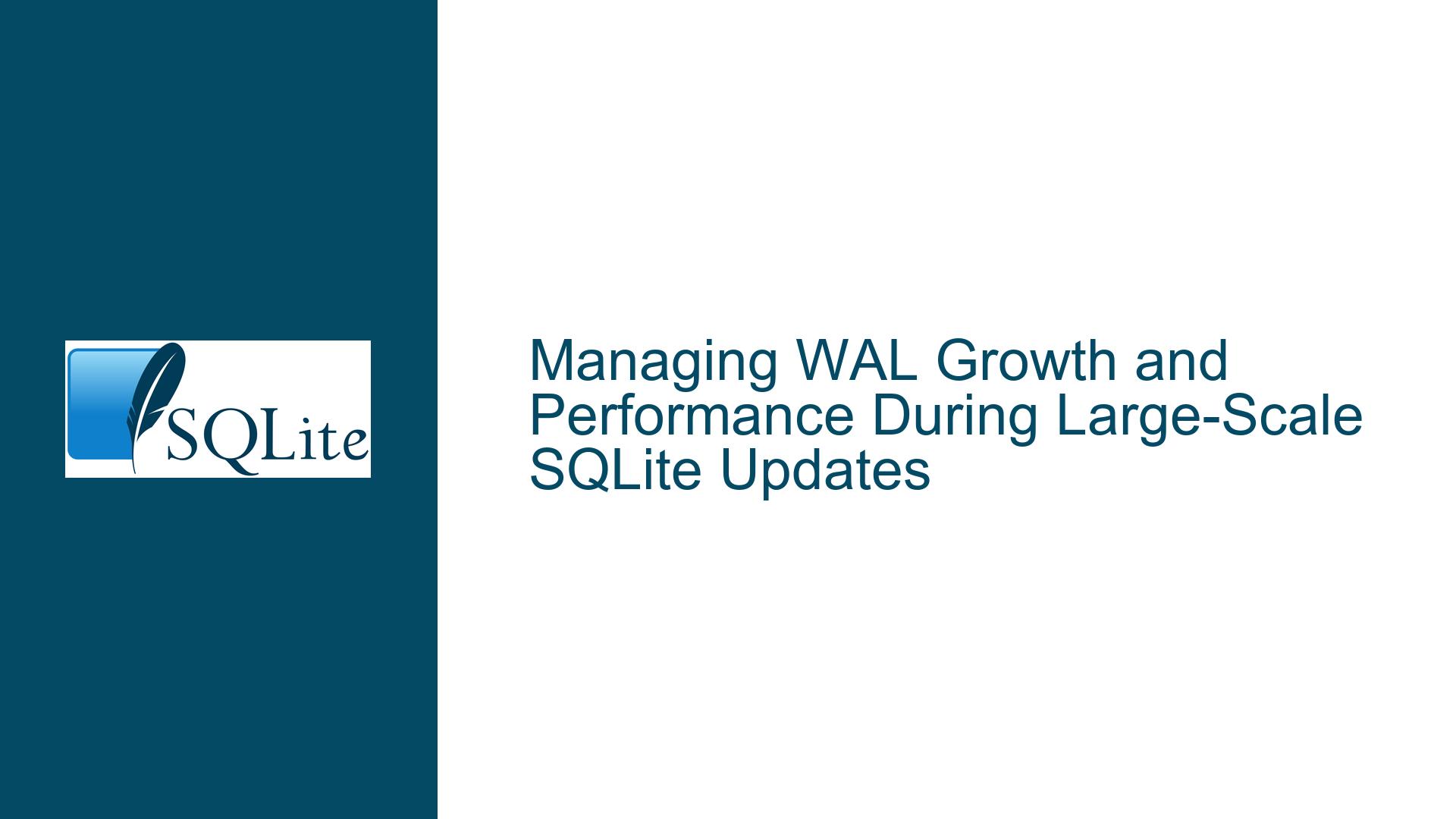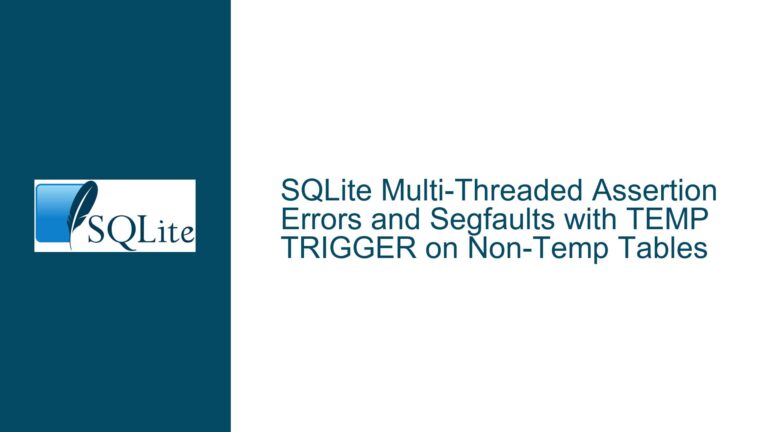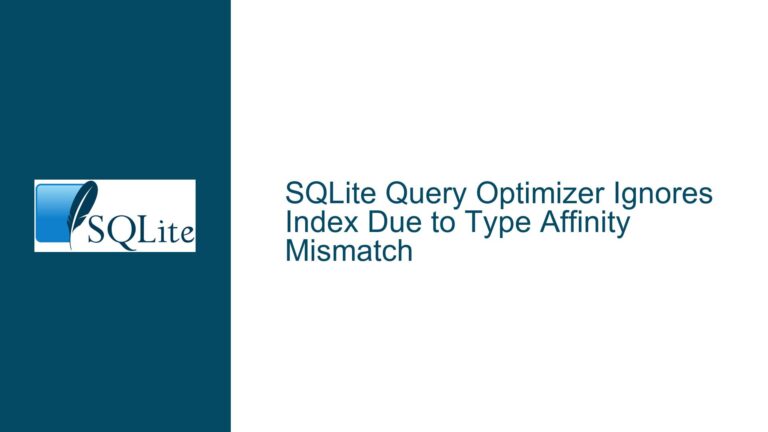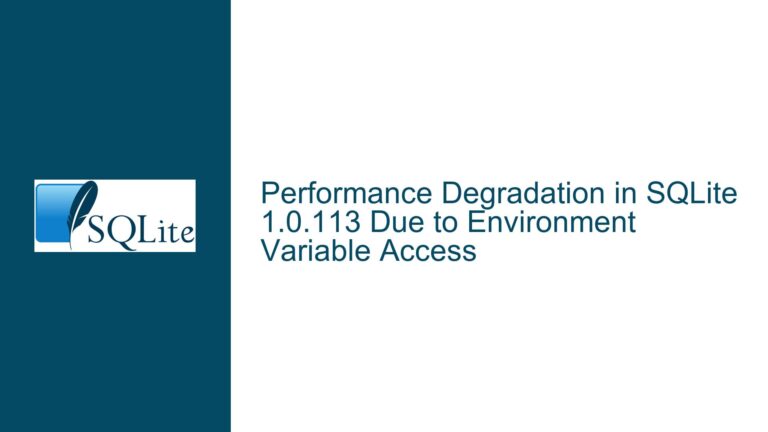Managing WAL Growth and Performance During Large-Scale SQLite Updates
Understanding WAL File Expansion During Full-Table Column Updates
Context of the Problem
A SQLite database with a 5 TB single-table schema is experiencing rapid growth of its Write-Ahead Logging (WAL) file during an UPDATE operation that modifies nearly all 30 million rows. The table structure includes a BLOB column (tile_data), which stores large binary objects, and a UNIQUE constraint on three integer columns. The operation in question is updating the zoom_level for most rows, which triggers row-level rewrites. The WAL file has already grown to 7 GB, raising concerns about whether it could balloon to 5 TB and how to mitigate performance degradation.
Key Technical Factors
- Row Rewrite Overhead: SQLite’s MVCC (Multi-Version Concurrency Control) mechanism requires rewriting the entire row during an
UPDATE, including all columns, even if only one column changes. When a row contains largeBLOBdata, this results in significant I/O operations. - WAL Mechanics: The WAL file accumulates changes until a checkpoint occurs, which transfers modifications back to the main database file. A single large transaction (e.g., updating 30 million rows) defers checkpointing until the transaction commits, causing the WAL to grow proportionally to the transaction’s data footprint.
- Index and Constraint Overhead: The
UNIQUE (zoom_level, tile_column, tile_row)constraint forces index updates for every modifiedzoom_level, compounding write amplification.
Root Causes of WAL Proliferation and Slow Performance
1. BLOB Storage Inefficiency in Row Modifications
Storing large BLOB values directly in the tiles table means every UPDATE to zoom_level requires rewriting the entire row, including the tile_data column. For example, a 1 MB BLOB in each row would necessitate rewriting 30 million * 1 MB = 30 TB of data during the update. This directly impacts WAL growth, as each modified row is logged.
2. Single-Transaction Update Strategy
Executing the UPDATE as a single transaction prevents SQLite from checkpointing until the transaction completes. The WAL file must retain all changes until the transaction commits, effectively mirroring the size of the modified data. If all 5 TB of data is modified, the WAL could theoretically reach 5 TB, though practical limits (e.g., filesystem constraints) may intervene.
3. Lack of Incremental Checkpointing
Without manual intervention, SQLite’s automatic checkpointing only occurs when the WAL reaches a threshold size (default: 1000 pages) and all connections release the database. A long-running transaction blocks automatic checkpointing, forcing the WAL to accumulate all changes.
4. Write Amplification from Indexes
The UNIQUE constraint on (zoom_level, tile_column, tile_row) requires updating the associated index whenever zoom_level changes. This doubles the write operations: one for the table row and another for the index entry.
Mitigation Strategies, Schema Optimizations, and Configuration Tuning
1. Schema Redesign: Decoupling BLOB Data
Problem: Rewriting large BLOB values during zoom_level updates is unnecessary and wasteful.
Solution: Store BLOB data in a separate table and reference it via a foreign key.
Step-by-Step Implementation:
Create a new table for
BLOBstorage:CREATE TABLE tile_blobs ( blob_id INTEGER PRIMARY KEY, tile_data BLOB NOT NULL );Modify the
tilestable to referencetile_blobs:CREATE TABLE tiles ( id INTEGER PRIMARY KEY, zoom_level INTEGER NOT NULL, tile_column INTEGER NOT NULL, tile_row INTEGER NOT NULL, blob_id INTEGER NOT NULL REFERENCES tile_blobs(blob_id), UNIQUE (zoom_level, tile_column, tile_row) );Migrate existing data:
INSERT INTO tile_blobs (tile_data) SELECT tile_data FROM tiles; UPDATE tiles SET blob_id = (SELECT blob_id FROM tile_blobs WHERE tile_data = tiles.tile_data);Note: This assumes
tile_datais unique. If not, use a deduplication step.Drop the original
tile_datacolumn:CREATE TABLE tiles_new AS SELECT id, zoom_level, tile_column, tile_row, blob_id FROM tiles; DROP TABLE tiles; ALTER TABLE tiles_new RENAME TO tiles;
Impact:
- Updating
zoom_levelnow only rewrites the integer columns (id,zoom_level,tile_column,tile_row,blob_id), drastically reducing per-row I/O. - The WAL growth is proportional to the smaller row size, not the
BLOBsize.
2. Chunked Updates with Manual Checkpointing
Problem: A monolithic UPDATE transaction risks WAL explosion.
Solution: Break the update into smaller transactions and force periodic checkpoints.
Implementation:
- Identify a range of rows to update (e.g., using
idranges):UPDATE tiles SET zoom_level = $x WHERE zoom_level = $y AND id BETWEEN 1 AND 10000; - After each batch, commit the transaction and checkpoint the WAL:
PRAGMA wal_checkpoint(TRUNCATE); - Automate the process with a script (e.g., Python):
import sqlite3 conn = sqlite3.connect('large_db.sqlite') batch_size = 10000 max_id = 30_000_000 # Adjust based on actual data for start in range(1, max_id, batch_size): end = start + batch_size - 1 conn.execute(f""" UPDATE tiles SET zoom_level = $x WHERE zoom_level = $y AND id BETWEEN {start} AND {end} """, (new_zoom, old_zoom)) conn.commit() conn.execute("PRAGMA wal_checkpoint(TRUNCATE);")
Optimization Tips:
- Adjust
batch_sizebased on available RAM and disk speed. Smaller batches reduce WAL growth but increase transaction overhead. - Use
PRAGMA synchronous = OFFandPRAGMA journal_mode = WALduring batch updates to reduce I/O latency. Warning: This risks data corruption on power loss.
3. Index Management During Bulk Updates
Problem: Index maintenance during updates slows down operations.
Solution: Temporarily drop and recreate the index.
Steps:
- Drop the
UNIQUEconstraint before the update:DROP INDEX tiles_unique_idx; -- Replace with actual index name - Perform the
UPDATEoperation. - Recreate the index:
CREATE UNIQUE INDEX tiles_unique_idx ON tiles (zoom_level, tile_column, tile_row);
Considerations:
- Index recreation is time-consuming for large tables but often faster than incremental updates.
- Ensure no concurrent writes rely on the index during this process.
4. Pragma Configuration for Large Transactions
Problem: Default SQLite settings prioritize safety over speed.
Solution: Adjust pragmas to optimize bulk updates.
Recommended Settings:
PRAGMA journal_mode = WAL; -- Required for checkpoint control
PRAGMA synchronous = NORMAL; -- Balances speed and durability
PRAGMA cache_size = -100000; -- Allocate 100MB of cache
PRAGMA temp_store = MEMORY; -- Store temp tables in RAM
PRAGMA mmap_size = 268435456; -- Allocate 256MB for memory-mapped I/O
Caveats:
PRAGMA synchronous = OFFspeeds up writes but risks data loss on crash.PRAGMA journal_mode = OFFdisables WAL entirely but eliminates transaction rollback capability.
5. Using Generated Columns for Static Transformations
Problem: If zoom_level updates follow a fixed formula (e.g., zoom_level = zoom_level + 1), a virtual column can avoid physical updates.
Solution: Use a VIRTUAL generated column.
Example:
CREATE TABLE tiles (
id INTEGER PRIMARY KEY,
original_zoom INTEGER NOT NULL,
tile_column INTEGER NOT NULL,
tile_row INTEGER NOT NULL,
tile_data BLOB NOT NULL,
zoom_level INTEGER GENERATED ALWAYS AS (original_zoom + 1) VIRTUAL,
UNIQUE (zoom_level, tile_column, tile_row)
);
Limitations:
- Virtual columns cannot be indexed in SQLite versions < 3.31.0.
- Queries must reference the virtual column explicitly.
6. Alternative: Offline Database Reconstruction
Problem: In-place updates are inherently slow for massive tables.
Solution: Build a new database with the desired zoom_level values.
Steps:
- Create a new table with the correct schema.
- Use
INSERT INTO ... SELECTto copy data with updatedzoom_level:INSERT INTO new_tiles (id, zoom_level, tile_column, tile_row, tile_data) SELECT id, $x, tile_column, tile_row, tile_data FROM tiles WHERE zoom_level = $y; - Drop the original table and rename the new one.
Advantages:
- Avoids update-in-place overhead.
- Allows parallelized reads from the old database during construction.
7. Monitoring and Mitigating WAL Growth
Tools:
- Check WAL size:
ls -lh yourdb.sqlite-wal - Monitor active transactions:
PRAGMA wal_checkpoint; -- Outputs active WAL frames
Emergency Mitigation:
If the WAL grows uncontrollably:
- Terminate the update process.
- Manually checkpoint and truncate the WAL:
PRAGMA wal_checkpoint(TRUNCATE); - Resume updates with smaller batches.
8. Filesystem and Hardware Considerations
- Disk Speed: A 5 TB database on HDDs will inherently suffer from high latency. Use SSDs for better throughput.
- Filesystem Choice: Use a filesystem that handles large files efficiently (e.g., XFS, ext4). Avoid FAT32/NTFS.
- Sparse Files: Ensure the filesystem supports sparse files to optimize space usage for partially filled databases.
9. Post-Update Maintenance
After completing the update:
- Rebuild the database to reclaim space:
sqlite3 old.db "VACUUM INTO 'new.db';" - Reanalyze table statistics:
ANALYZE;
By combining schema optimization, batch processing, and configuration tuning, the WAL growth can be constrained to manageable levels while significantly improving update performance. Always validate changes in a staging environment before applying them to production datasets.






